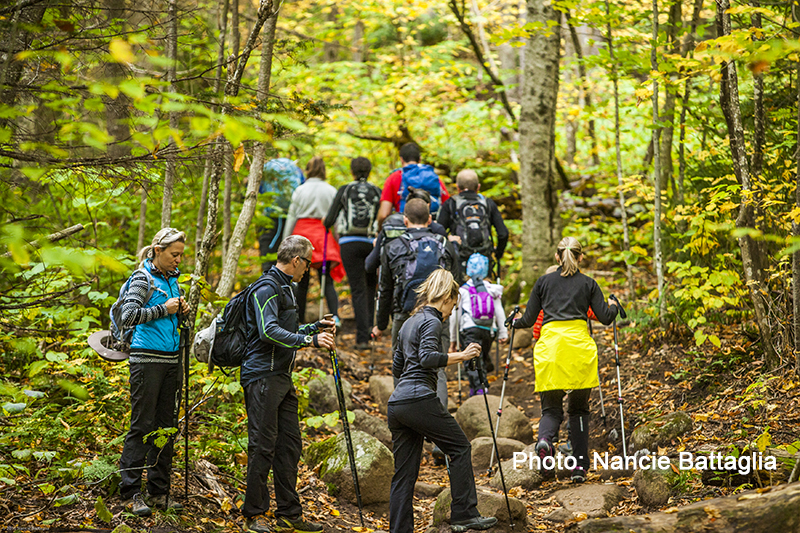
2018 Hiker Survey Results Summary
In the summer of 2018, the Adirondack Council conducted a survey in the High Peaks region of the Adirondack Park to assess hikers’ perceptions of overuse and possible state land management actions that could help address overuse. The survey was designed with guidance from partners at Colgate University. The Council received a temporary revocable permit from the Department of Environmental Conservation to conduct the survey on state land. Click HERE to download summary.
Aims of the Study
- Assess hikers’ perceptions of overuse in the High Peaks region,
- Assess level of support for potential state land management strategies, and
- Assess user characteristics, including age, race, residence and level of hiking experience.
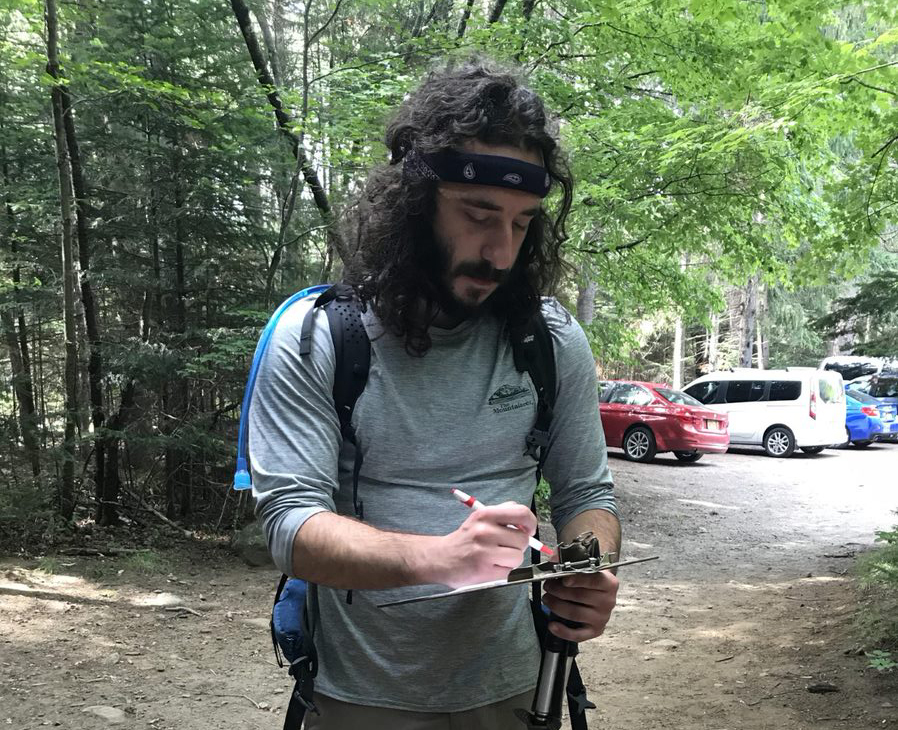
Methodology
- 11 question survey administered at 10 select trailheads in the High Peaks region
- Conducted from June to early October
- Parameters of survey: One survey per group; hikers over the age of 18; participants that could read/write English (self-identified); administered before hike
- Surveyed 3 days per week - totaling 25 field days
Overview of Numbers
- 1,209 groups were approached
- 1,004 surveys completed (one person per group)
- Response rate: 87.5%
- Participants from 31 states and 6 countries
Hiker Profile
- Average age is 37
- Over 50% of hikers identify themselves as experienced hikers in the High Peaks region
- Male hikers out-number female hikers at a ratio of nearly 1.5 to 1
- 11% of surveyed hikers are non-white
- 55% of surveyed hikers are from New York State
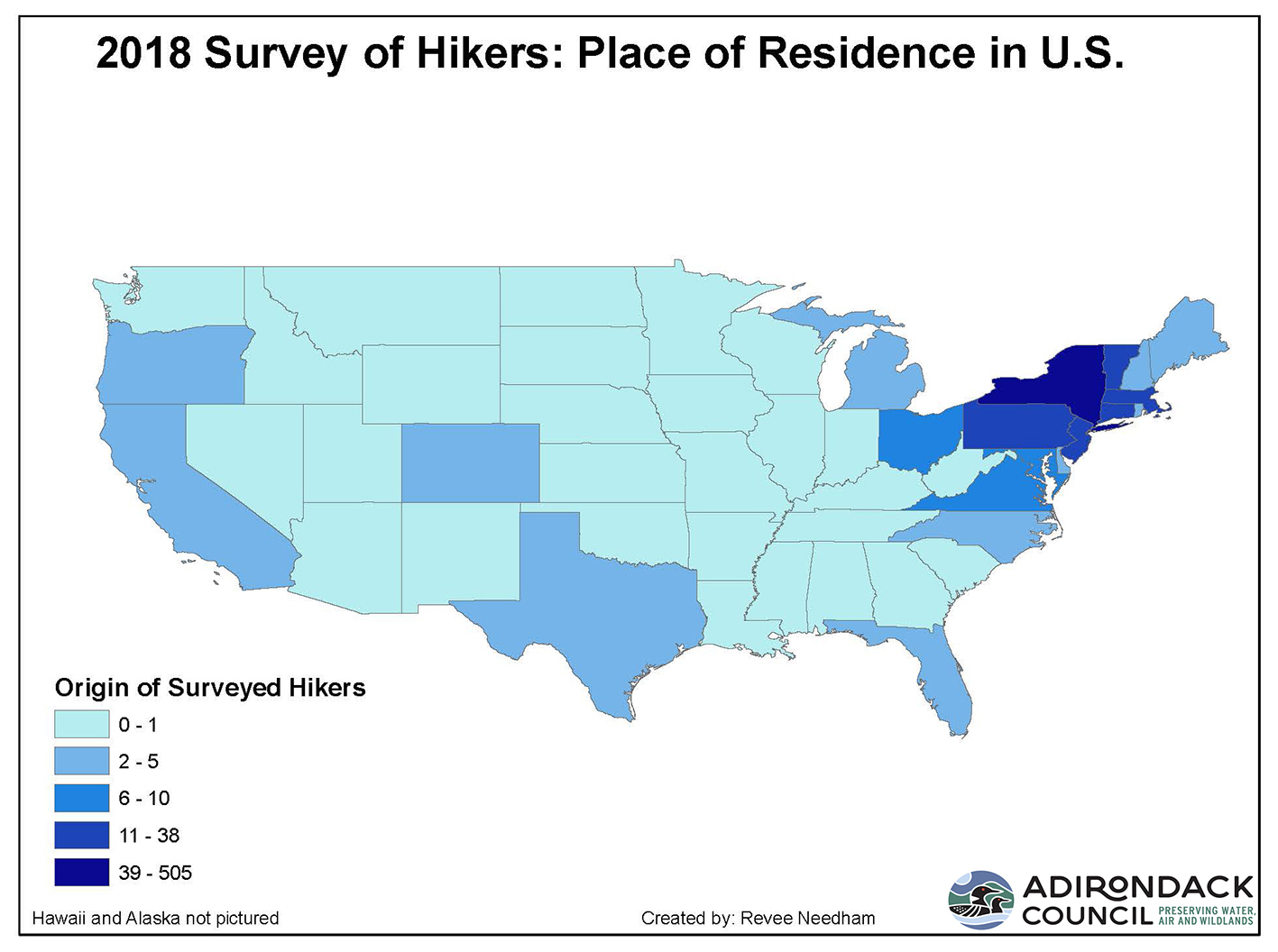
Headline Results
1. 70% to 20% (nearly 4 to 1) hikers support protection of wilderness character and sense of solitude over expanding recreational opportunities.
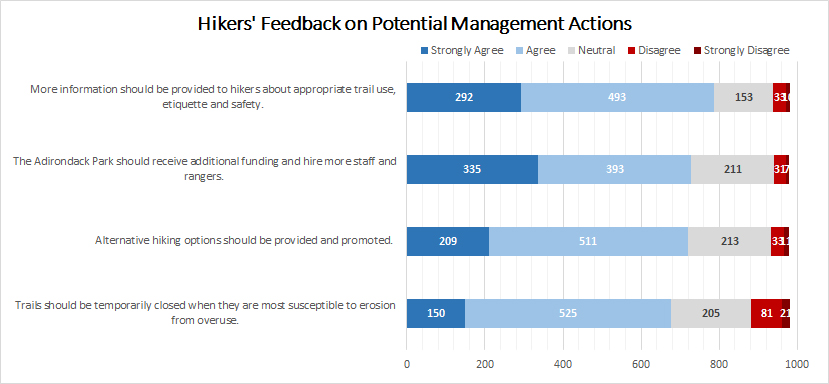
2. Hikers largely support management strategies that would increase funding and hire more staff and rangers in the Adirondack Park.

In the survey, hikers ranked their level of support for seven possible management actions that could address overuse and/or accommodate more use. Of the seven actions provided, four drew the most support. The graph below shows that 80% of hikers want more information made available/accessible to them regarding appropriate trail use, etiquette and safety by the state and stakeholders. In addition, 75% of hikers agree that the Adirondack Park should receive additional funding and hire more DEC staff and rangers to carry out not only increasing amounts of search and rescue missions, but to also perform other resource maintenance needs. Other highlights include:
- 2:1 hikers agree that the number of hikers should be limited at specific locations on high use dates.
- 80% of hikers want more information made available/accessible to them regarding appropriate trail use, etiquette and safety
- 2:1 hikers agree that trailhead parking should combine reservations and first-come-first-served options to control the maximum number of vehicles.
These results demonstrate that hikers continuously strive to be better prepared, better informed and better stewards of the land.
3. Majority of hikers identify themselves as experienced hikers.
Participants were asked to identify themselves as a first time, beginner, experienced or expert hiker. Surprisingly, we found that 65% of hikers identified as experienced or expert hikers. Popular trailheads like Cascade did have higher levels of less experienced hikers compared to other trailheads.
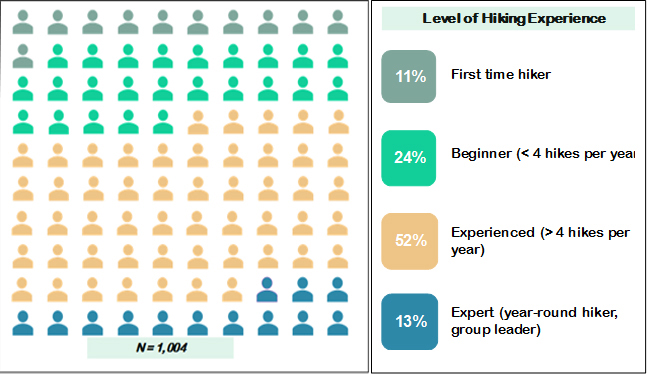
4. In comparing heavily-to-less used trails, we found that hikers at more remote trailheads tend to be experienced/expert hikers that decisively support wilderness protection.
Data collected at Cascade Mountain, well-known for its high levels of use, was compared to data collected at the more remote Upper Works trailhead. Here’s what we found:
- Upper works has a high level of experienced hikers, with at least 65% identifying as experienced hikers. This is higher than both Cascade (44%) and the total survey results (52%). Cascade has higher levels of first time (16%) and beginner hikers (32%) compared to Upper works and the total results.
- More experienced hikers agree that overuse is a problem and the state should take action to address it. Less experienced hikers often selected Neutral on the survey, which suggests that newer hikers are unfamiliar with the term "overuse."
- There appears to be a correlation between level of hiking experience and support for wilderness protection. Hikers at Upper Works decisively supported wilderness protection while disagreeing with the prioritization of recreational opportunities. Average priorities were different at Cascade.
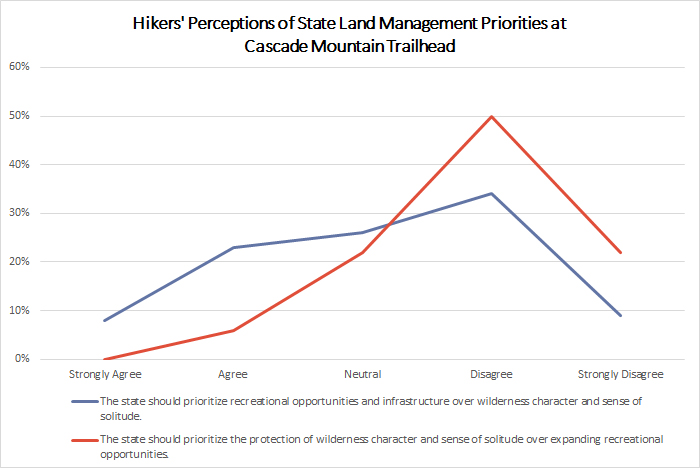
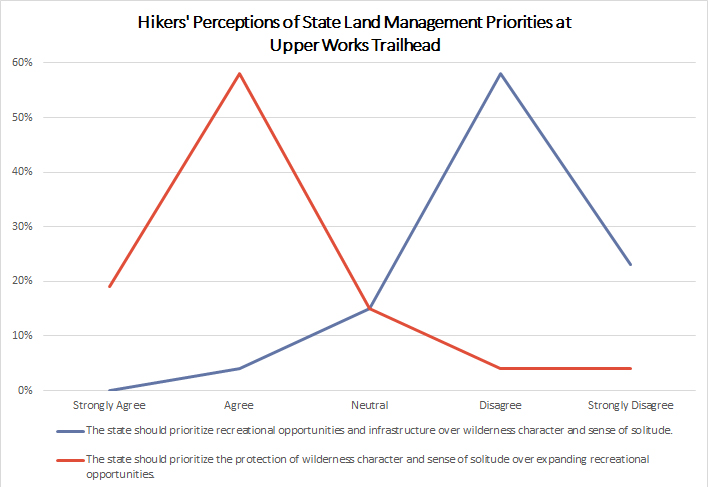
5. Online survey participants were even stronger in their support of state land management actions that protect wilderness than 2018 Hiker Survey.
The Council shared a condensed version of our 2018 Hiker Survey online to reach a wider audience. With over 1,500 participants, we found these results to be consistent with the field-administered survey results, with these results demonstrating even stronger support for resource protection and increased education. For example, over 90% of the online participants agree that a) more information should be provided to hikers and b) the Adirondack Park should receive additional funding as well as hire more staff and forest rangers.
In addition, online participants supported wilderness protection over recreation at a scale of nearly 7 to 1, which is stronger than the level of support we saw within the hiker survey (4 in 1 hikers support Wilderness).
Comments
Below are a handful of the 800+ comments we received from the online survey:
- “Overuse of the popular trails during the peak summer months (weekends especially) needs good stewardship and leadership by both the conservation and government organizations.”
- “It is a good problem to have! I am confident that with additional funding, a fair system of controls and education can be put in place.”
- “What you’re pushing for is going to devastate the local economy.”
- “I know this is a complicated issue. But if all concerned are involved in a solution, one can be found. That includes non-resident visitors, year-round residents (involved in the tourist industry as well as others), seasonal residents, etc.”
This survey was developed and implemented with input from multiple partners and the NYS Department of Environmental Conservation. The survey was not endorsed by the state and was not a state survey.
A special thank you to Meg Desmond Clarence Petty Conservation Intern and Revee Needham Colgate University Upstate Institute Summer Field School Fellow for their dedication to the hiker survey this summer, which included hours of field work and data processing.




